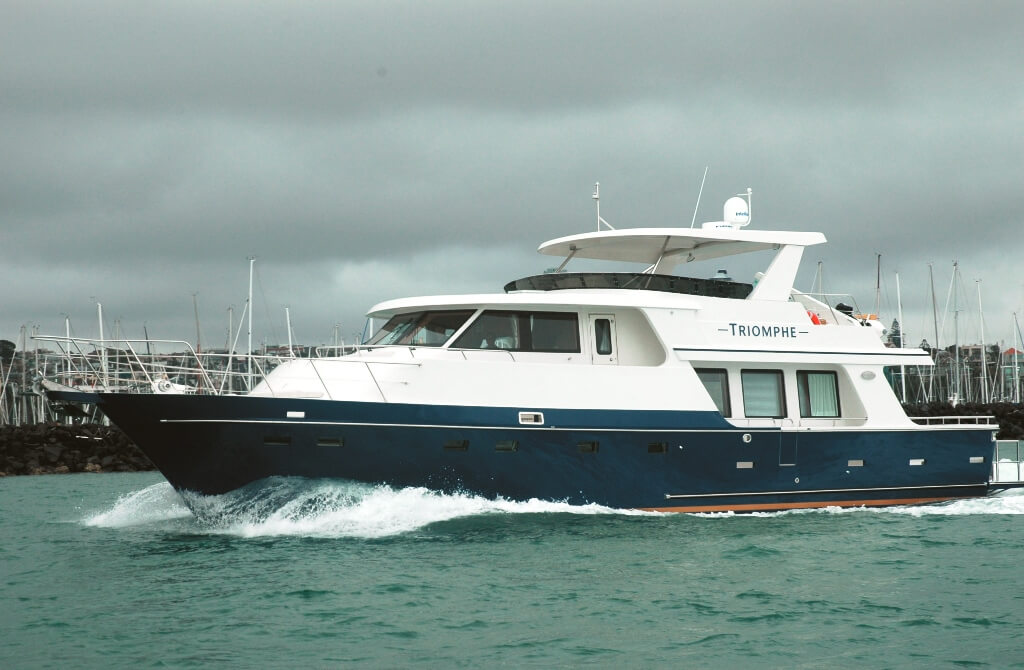Author : Barry Thompson
Classic Addition
Triomphe is the first Symbol 63C to be launched, the result of extending the already popular 59 Classic with a 2ft extension in the cockpit. The Nelson based owner liked the layout of the 59 but wanted more cockpit space for fishing and the builders were happy to oblige.
The result was certainly justified, with a large workable cockpit, without compromising the saloon or interior spaces. With the additional running surface, designer Jack Sarin was contracted to reconfigure the positioning of all the machinery and tankage to achieve the correct balance.
So successful has the new design been that Symbol Yachts has added the 63C to its range. Two versions are available, one with and one without a Portofino style stern, plus there are variations available on the hardtop extension and like all Symbol Yachts, plenty of opportunity to customise the interior.
The ‘new’ 63C joins seven other Classic models from the 42 Classic to the 63 Euro Classic. Jack Sarin describes the Symbol Classic range as boats that are a no-nonsense vessel that are capable of serious longer-range cruising and longer stays on board.
“This meant an emphasis toward a more live-aboard approach, at least to the extent that the boats are designed to be self-sufficient for longer periods of time, possibly spending many days, weeks or even months gunk-holing through uninhabited islands”, said Sarin.
He points out that like many of his designs, the Classic range utilises his own cruising experience and extending it to areas of the design, which might eliminate situations that he has found himself in and does not want to repeat.
“I attempt to “cruise” the boat while it is still on paper, incorporating any feature that I feel is a solution to the multitude of problems that can confront an owner. Attention to proper sight lines, ease of anchoring, manoeuvring in tight spaces, access to machinery and equipment, etc.”, says Sarin.
The Classic is not meant to be a fast cruising boat. In fact, Sarin has probably slowed its top speed down, with a keel that is deeper than usual in order to be more protective of the props and running gear. Using the same parent hulls that have proved to be dry and seaworthy on the 54’/58′ Raised Pilot House models they have modified and filled in the aft spray strake area to give a wider waterline beam. Since these models carry a little more fuel for longer range than their sisters and have additional weight due to the layout and structural design, the additional buoyancy is required to absorb the additional weight. The standard 59 Classic displacement is 39 tonnes and with the 63C this has risen to around 45.5 tonnes.
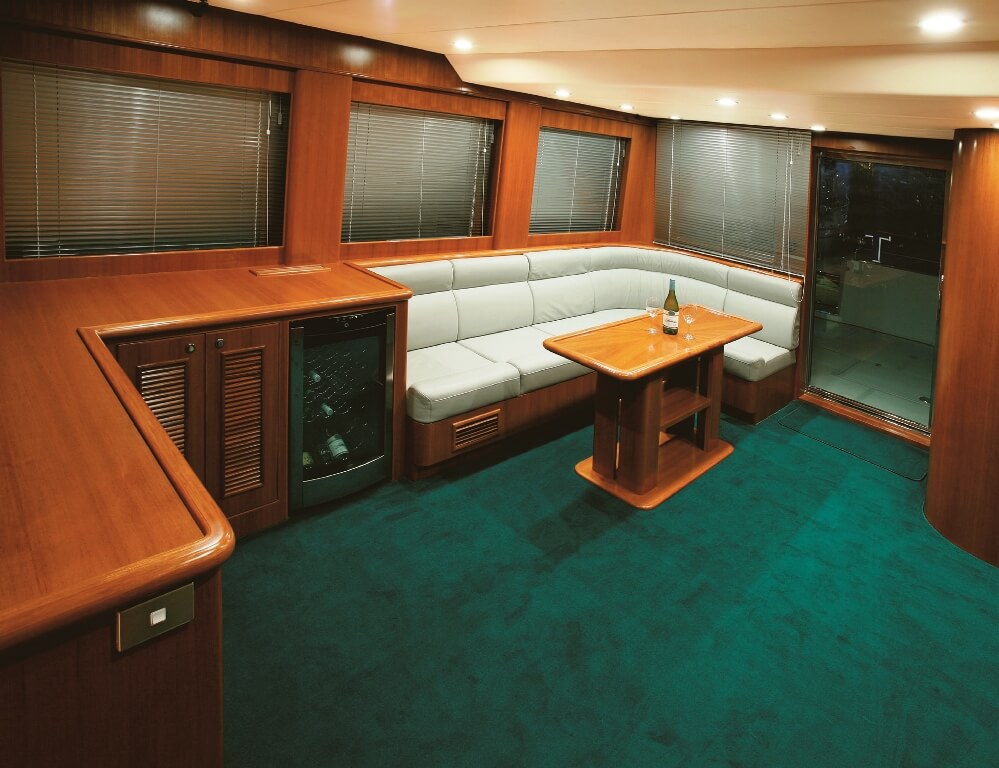
Scania Power
For those who want to get in the low 20 knot area, twin 800 horsepower engines will be required but, depending on an individual’s speed and range requirements, the more standard horsepower would be in the range of 500hp – 700hp.
The owner of Triomphe chose a pair of 650hp Scania engines that return a top speed of 19 knots and a comfortable cruise range of 12-15 knots. In choosing the Scanias he said “They are strong engines that have a great reputation in the work boat market for reliability and that is certainly something that was extremely important to me, especially when passage making”, he said.
The first Symbol 63C in Australia was powered with a pair of 480hp Yanmars and returns a maximum speed around 15 knots. Engine room access is through watertight access doors in the aft bulkhead leading into the lazarette, which, in turn, is accessed by means of a hatch and stairs from the aft deck.
When the owner first approached the New Zealand broker for Symbol Yachts, Terry Needham, of All Boat Brokerage, one of the prerequisites was that the boat had to be capable of being built to New Zealand survey classification. Not only is Triomphe to be used for recreational use, plans are also for some luxury charter around the Nelson/Marlborough Sounds area and also Fiordland. Fortunately that wasn’t an issue, with the factory happy to oblige with any alterations that needed to be done.


“Structurally we changed very little, apart from increasing the thickness of the toughened glass screens, adding an extra hull stiffener and changing the shape of the watertight bulkhead in the bow,” said Terry.
Customised Interior
When you order a Symbol, you have a certain amount of freedom to customise the interior, although Triomphe basically conforms to a standard layout.
While the smaller Classic models offer the popular galley/dining area up and adjacent to the pilot house area, the Classic 63C, because of its additional length, also offers a galley down version with a large settee with table for dining at the aft end of the pilot house. This in turn opens up the helm area and provides space for a second pilot or observer chair on a raised step or even a small captain’s cabin.
The owner of Triomphe chose the galley up version but repositioned the full size fridge/freezer and raised the pilothouse settee for better external viewing. The galley is large and well equipped, with an under-bench dish drawer, electric oven, four-burner gas hob and convection microwave.
At the centre of the helm is a white Pompanette chair and large ship’s wheel. Twin screens display all the necessary Furuno based navigation displays. To port, the leather day lounger and dining table is certain to be one of the favoured entertaining areas aboard.
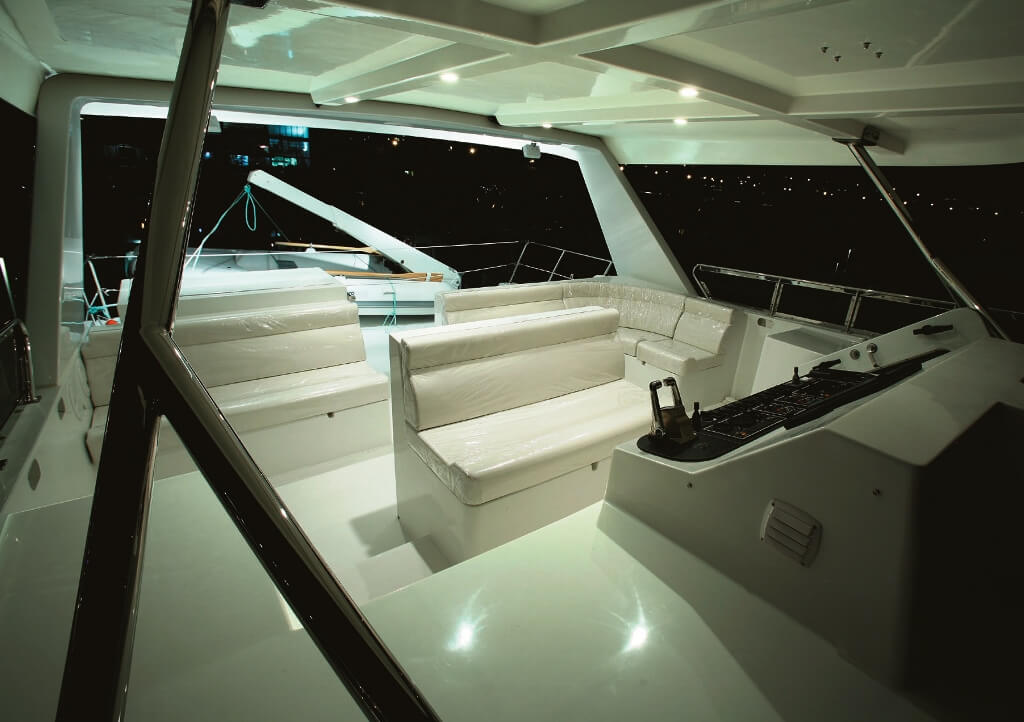
The helm, galley and settee spaces all blend in well together. Dutch doors either side provide easy access to the side decks and forward areas.
The main saloon is generously designed with side storage lockers and areas designated for the pop-up TV, wine cooler, entertainment centre and icemaker. The owner is due to add a couple of tub chairs to surround the large formal dining area that can seat 6 to 8 for a meal.
A sliding stainless door gives access through to the extended cockpit that has deliberately been kept spacious and uncluttered for serious fishing. There is a huge ice locker/wet storage bin aft of the lazarette, storage lockers under the coamings and a port side day head with shower.
The 63C Symbol features covered side decks and a Portuguese bridge around the front of the pilothouse, with a central door leading to the foredeck. Ample stowage with lockers in the bridge front is accessed from the walk-around space just forward of the pilothouse and, additionally, in the deck lockers on the foredeck. There is a great area here for sunbathing or just relaxing – ideal for enjoying the scenery around the Marlborough Sounds or Fiordland. The raised bow pulpit is designed to carry two anchors and is fitted with the latest Lofrans hydraulic windlass.
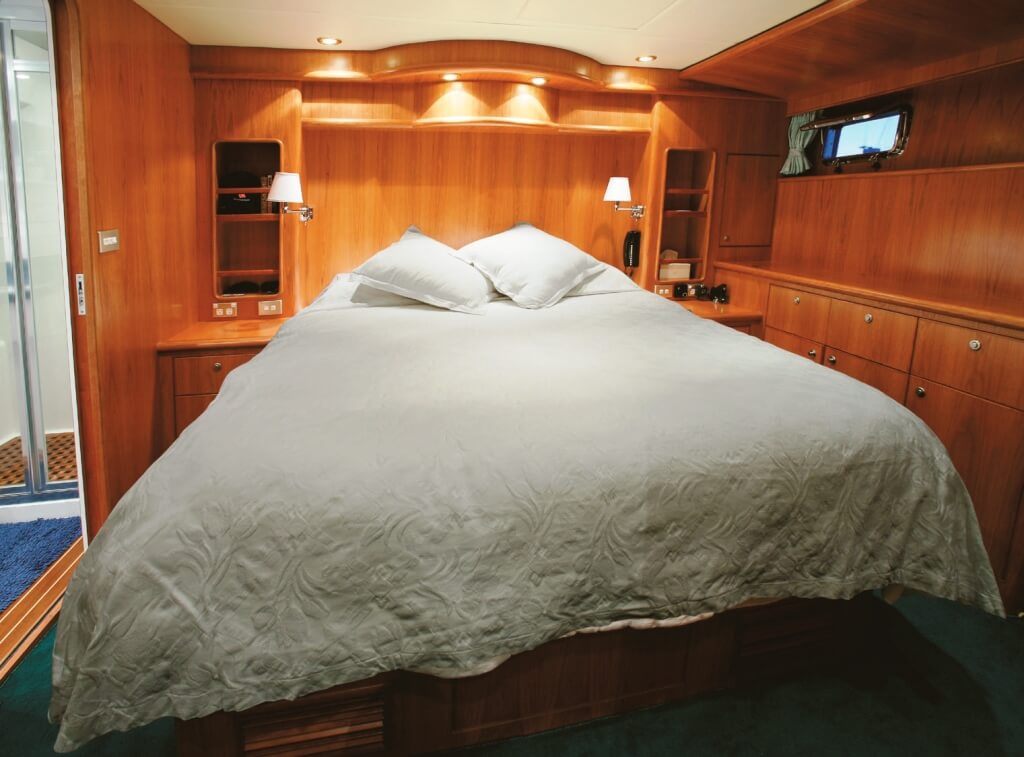
Three-Cabin Layout
Triomphe is a three-cabin boat with access to the lower deck accommodation by way of a curved stairway to starboard. The living spaces featuring an amidships full-beam master stateroom with generous ensuite head, a forward V.I.P. guest stateroom with a queen-size berth and a third smaller guest cabin or office, depending on the owner’s choice, with a head located to starboard that can be an ensuite head to the V.I.P stateroom or shared. Triomphe’s port guest cabin provides accommodation for three, with twin lower singles and a Scotsman berth above.
All three cabins feature generous lockers, drawers and storage spaces, with opening ports adding extra light and ventilation. Interestingly, the owner opted not for air conditioning but an Eberspacher diesel heater, something he feels is more necessary in the Deep South than cool air! Even the towel rails are heated through this system.
A stacked washer/dryer is located in the passageway at the bottom of the stairs. Triomphe’s interior timber is predominantly all teak, apart from the owner’s stateroom, which is finished in American cherry. Again, this was the owner’s choice.

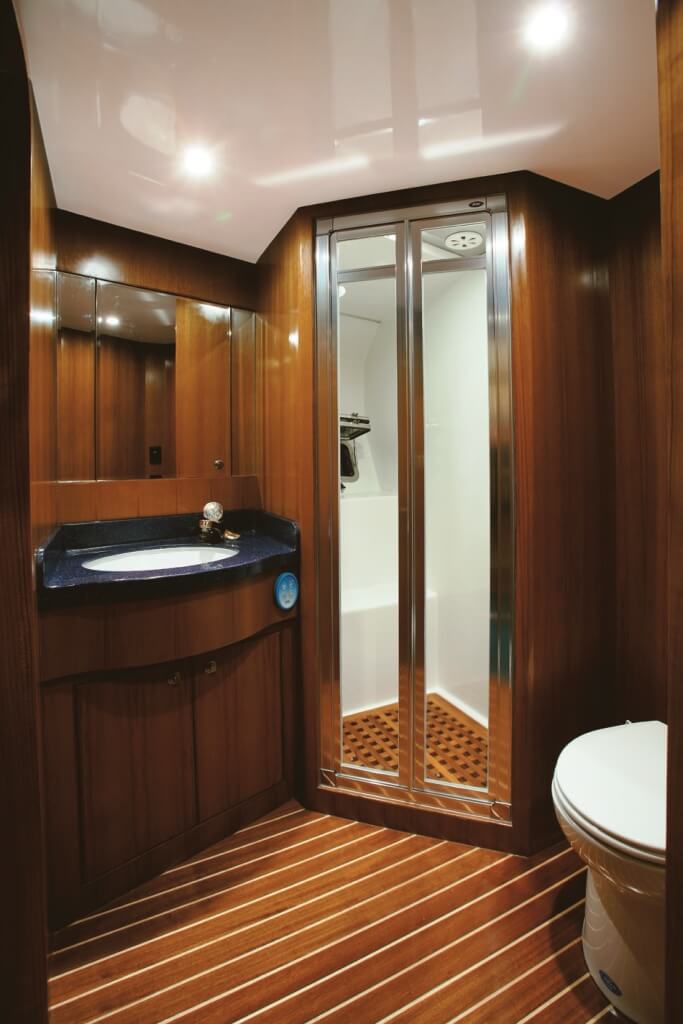
Open Flying Bridge
The flying bridge is extended outboard, with headroom pockets over the side deck stairs to allow a spacious lounge area aft of the centre steering station, which accommodates the tender and liferaft. The port side settee with table can comfortably seat four for dining, and has excellent viewing angles in all directions. Triomphe has a seat locker for miscellaneous gear stowage to port aft of the settee and a BBQ/refer/sink food prep counter is located to starboard. Access to the flying bridge forward is from a hatch over a free-standing stairway at the aft port side of the pilot house which also serves to open the visibility for the helmsman to glance aft while underway and visually opens the entire saloon/pilot house to each other.
Access to the boat deck from the aft deck is by way of a teak and stainless steel ladder up through a hatch, which can be closed during inclement weather. Triomphe has the optional hardtop with stainless steel supports and clip-on clears. If you want a fully enclosed hardtop, this would need to be retrofitted in New Zealand or Australia.

As have all other Symbol models, the hull is a solid laminate on the keel and bottom up to the chine and then cored with cross-linked PVC foam, the entire hull being strengthened with web frames and moulded FRP stiffeners.
The Kiwi influence on the Symbol 63 Classic has been so well accepted that the Taiwanese factory has now added the model to its standard Classic range. It has certainly improved what was already a great boat. Had the factory not been prepared to make the alterations to the hull, the Kiwi owner would have probably bought something else. And then maybe there would never have been a 63C and that would have been a shame.
Triomphe is certainly a Kiwi’s triumph!
Specifications
- Design Name: Symbol 63C Classic
- Boat Name: Triomphe
- Year Launched: 2008
- Classification: NZ Survey
- Designer: Jack Sarin
- Interior Designer: In house
- Builder: Symbol Yachts
- LOA: 18.37 m
- Beam: 5.33 m
- Draft: 1.45 m
- Displacement: 45.4 ton
- Max Speed: 19 knots
- Cruise Speed: 15 knots
- Construction: GRP
- Fuel Cap: 3780 litres
- Water Cap: 938 litres
- Engines Make: 2 x Scania 650 @ 650hp


